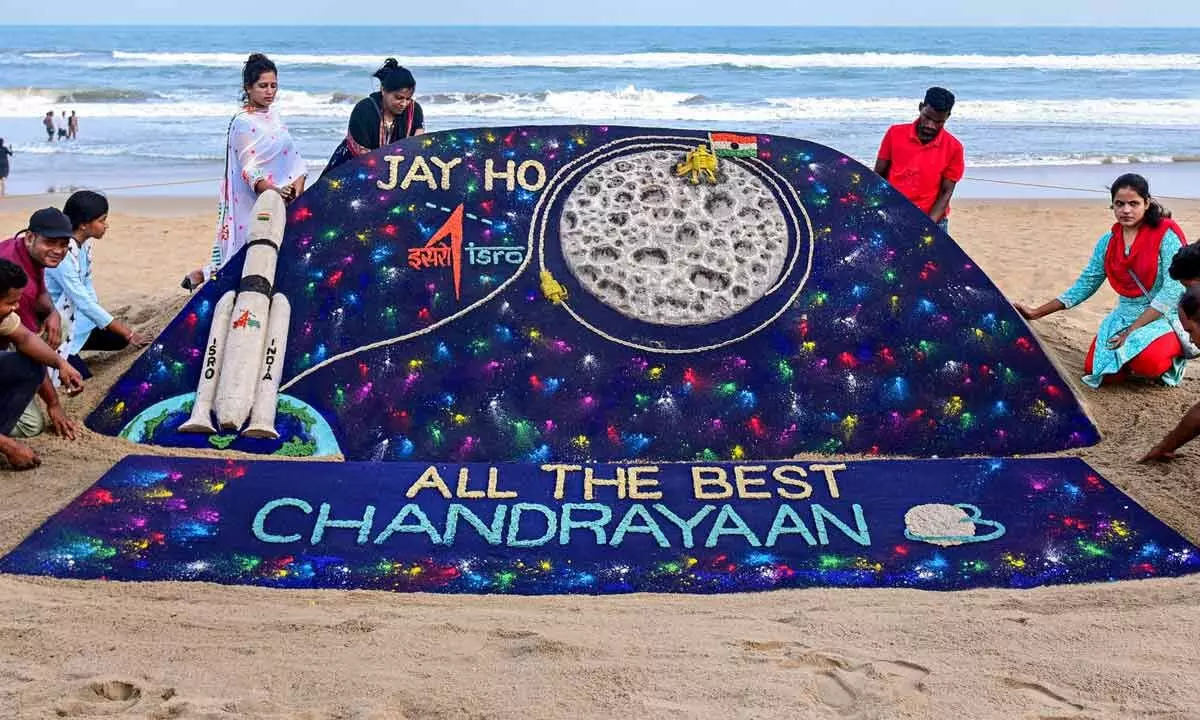Live
- Three persons admitted to hospital for diarrhea treatment
- First Star Outside Milky Way Captured: WOH G64 is 2,000 Times Larger Than the Sun
- Sikkim govt to constitute state Niti Ayog: CM Tamang
- CBI books Rajasthan narcotics inspector for Rs 3 lakh bribe
- Rajasthan bypolls: A tough contest between BJP and Congress
- Albania joins SEPA, paving way for EU integration
- Japanese government approves 250-billion USD economic package to ease price pain
- Six pharma companies to set up their units in Telangana
- The Unstable Events of a 17-Wicket Day in Perth: India vs Australia
- Dutch FM's Israel trip cancelled after Netanyahu's arrest warrant
Just In

Students of Sudarsan Sand Art Institute create a sand art on ISRO’s lunar mission Chandrayaan-3 at the beach, in Puri on Tuesday
Chandrayaan-3 gets ready to make history with soft-landing on Moon's surface at 6:04 pm today
Bengaluru: ISRO's ambitious third Moon mission Chandrayaan-3's Lander Module (LM) is all set to land on the lunar surface on Wednesday evening, as India eyes to become the first country to reach the uncharted south pole of Earth's only natural satellite.
The LM comprising the lander (Vikram) and the rover (Pragyan), is scheduled to make a touch down near the south polar region of the Moon at 6:04 pm on Wednesday.
If the Chandrayaan-3 mission succeeds in making a touchdown on moon and in landing a robotic lunar rover in ISRO's second attempt in four years, India will become the fourth country to master the technology of soft-landing on the lunar surface after the US, China and the erstwhile Soviet Union. Chandrayaan-3 is a follow-on mission to Chandrayaan-2 and its objectives are to demonstrate safe and soft-landing on the lunar surface, roving on the Moon, and to conduct in-situ scientific experiments.
Chandrayaan-2 had failed in its lunar phase when its lander ‘Vikram’ crashed into the surface of the Moon following anomalies in the braking system in the lander while attempting a touch down on September 7, 2019. Chandrayaan’s maiden mission was in 2008.
The Rs 600-crore Chandrayaan-3 mission was launched on July 14 onboard Launch Vehicle Mark-III (LVM-3) rocket, for a 41-day voyage to reach near the lunar south pole. The soft-landing is being attempted days after Russia’s Luna-25 spacecraft crashed into the Moon after spinning out of control. After the second and final deboosting operation on August 20, the LM is placed in a 25 km x 134 km orbit around the Moon.
The module would undergo internal checks and await the sunrise at the designated landing site, ISRO has said, adding that the powered descent -- to achieve soft-landing on the Moon’s surface -- is expected to be initiated at around 5:45 pm on Wednesday.
A day before the scheduled touch-down, ISRO on Tuesday confirmed that the Chandrayaan-3 mission is on schedule.
The space agency said the Mission Operations Complex (MOX), located at the ISRO Telemetry, Tracking and Command Network (ISTRAC) here, is buzzing with energy and excitement.
“The mission is on schedule. Systems are undergoing regular checks. Smooth sailing is continuing,” ISRO said in an update this afternoon, adding that the live telecast of the landing operations at MOX/ISTRAC begins at 5:20 pm on Wednesday.
ISRO’s Space Applications Centre Director Nilesh Desai said, “If any health parameter (of the lander module) is found abnormal on August 23, then we will delay the landing by four days to August 27.”
ISRO on Tuesday also released images of the Moon as captured by the Lander Position Detection Camera (LPDC) of the Chandrayaan-3 mission on August 19, and by Lander Imager Camera 4 on August 20.
LPDC images assist the LM in determining its position (latitude and longitude) by matching them against an onboard moon reference map, according to the Bengaluru-headquartered national space agency.
The critical process of soft-landing has been dubbed by many including ISRO officials as “17 minutes of terror”, with the entire process being autonomous when the lander has to fire its engines at the right times and altitudes, use the right amount of fuel, and scan of the lunar surface for any obstacles or hills or craters before finally touching down.
After checking all the parameters and deciding to land, ISRO will upload all the required commands from its Indian Deep Space Network (IDSN) at Byalalu near here, to the LM, a couple of hours before the scheduled time touchdown.
According to ISRO officials, for landing, at around 30 km altitude, the lander enters the powered braking phase, and begins to use its four thruster engines by “retro firing” them to reach the surface of the moon, by gradually reducing the speed. This is to ensure the lander doesn’t crash, as the Moon’s gravity will also be in play.
Noting that on reaching an altitude of around 6.8 km, only two engines will be used, shutting down the other two, aimed at giving the reverse thrust to the lander as it descends further, they said, then, on reaching an altitude of about 150-100 metres, the lander using its sensors and cameras, would scan the surface to check whether there are any obstacles and then start descending to make a soft-landing.

© 2024 Hyderabad Media House Limited/The Hans India. All rights reserved. Powered by hocalwire.com







